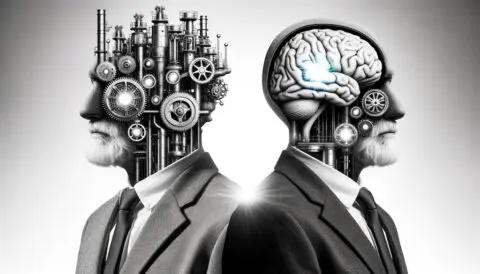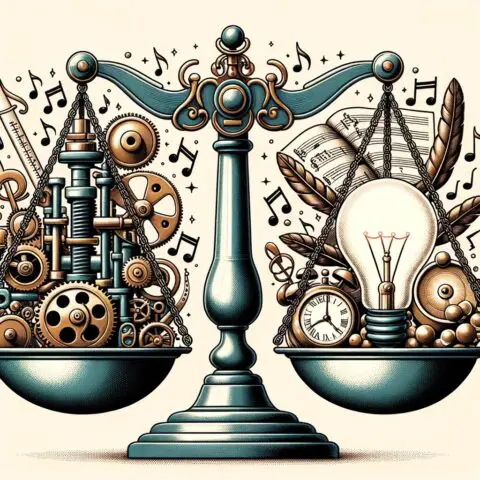Intellectual property is a legal domain, subdivided into two distinct branches: literary and artistic intellectual property, which includes copyrights and related rights, and industrial property, which comprises two major categories: rights related to industrial creations and those related to distinctive signs. These rights hold significant importance within a company, understanding the distinctions and associated consequences is fundamental for effective asset protection. Industrial Property versus Intellectual Property: what’s the difference? is the legal question we will address in this article.
This article will first explore the fundamental principles of industrial property before delving into the world of intellectual property and its two literary and artistic aspects. We will then examine the key differences between these two domains and conclude by analyzing their impact on creativity and innovation.
I – Industrial Property
Industrial Property is a cornerstone of intellectual property encompassing a set of specific rights derived directly from various distinct legal titles, including patents, trademarks, industrial designs, and geographical indications.
The major characteristic of industrial property lies in the fact that the rights attached to the different legal titles do not automatically emanate from the intellectual creation of the object of the right, but rather they stem from specific administrative formalities related to the filings and procedures for obtaining legal titles related to industrial property rights.
The field of industrial property is subdivided into two distinct categories. The first category addresses creations of a technical nature, while the second category deals with distinctive signs to enable the identification or designation of a product or service.

A. The Industrial Creation
1. The Patent
The patent law is multifaceted and depends on the technical domains of the objects protected by patents, integrating into an interdisciplinary context where law converges with other fields of knowledge, such as science.
A patent is a title granted by the competent public authorities of a given state or region. It confers on its holder a temporary and geographical monopoly over the exploitation of the invention it refers to, whether it is a product, a process, or a method.
Patents have a lifespan of 20 years from the filing date, subject to the payment of maintenance fees to the relevant offices. This 20-year duration allows the inventor to benefit from a period of exclusivity to exploit and commercialize their innovation while protecting their interests. Beyond this duration or in case of failure to pay maintenance fees, the invention falls into the public domain.
Decision-makers within companies must consider various aspects related to patents when developing their intellectual property strategy. In this context, decision-makers often rely on intellectual property advisors (IPAs). However, the use of patent management software can be an ideal tool. It provides a comprehensive view of deadlines, formalities, and costs associated with holding a patent portfolio.
2. Design and Model Law
Design and model law concerns the appearance of products, primarily engaging the senses of sight and touch. It distinguishes between two categories: designs, which involve elements in two dimensions, and models, which relate to elements in three dimensions.
Among industrial property rights, design and model rights are used to protect a specific appearance, whether it’s a product, a design element, or a digital object in a user interface of software or a mobile application. These rights are not limited to shape and also encompass the visible aspect of an object. They offer a broad scope of action, often complementary to invention patents, allowing the holder of these industrial property assets to exercise exclusive control over the object’s exploitation through legal tools somewhat different from those available for patent rights.
An essential point to remember is that a design and model can be renewed every five years by paying a maintenance fee, for a maximum duration of 25 years.
Similar to patents, management software can also provide an overview of formalities, especially considering the renewal deadlines every 5 years, associated with design and model rights.
B. Distinctive Signs: Trademark Law
In addition to patents, industrial property also encompasses the protection of distinctive signs, which include trademarks.
A trademark is a perceptible sign affixed to a product or accompanying a product or service, intended to distinguish it from similar products of competitors or services provided by others. There are different types of trademarks, including sound marks, such as advertising jingles, visual marks, such as logos and emblems, and verbal marks, comprising specific words or expressions.
The duration of trademark rights is generally 10 years from the date of application. This right can be renewed indefinitely every 10 years by paying renewal fees to the relevant offices. Unlike other intellectual property rights, trademarks can be renewed indefinitely. However, protection is limited to the territory where the application was filed and within the chosen classifications.
This mechanism ensures long-term protection of trademarks, allowing companies to maintain their identity and strengthen their market position by cultivating a brand image that makes them identifiable compared to other players.
In the case of trademarks, using a portfolio management tool allows for centralizing and tracking all information related to the company’s trademarks, including filing dates, renewals, registrations, and potential disputes. This management approach will ensure continuous and effective protection of trademarks, avoid unnecessary costs, identify opportunities for brand expansion, and maintain compliance with regulations.

II. Intellectual Property: The Field of Literary and Artistic Creation
Intellectual property, through its two components of literary and artistic creation, seeks to protect creations of the mind, especially those of a literary, artistic, musical, and even software nature. It is divided into two major categories of rights: copyright and neighboring rights.
In the realm of literary and artistic intellectual property, rights arise spontaneously upon the creation of a work, and the duration of protection typically spans the author’s entire life, plus approximately 50 years after their death (this duration varies by country), after which the work becomes accessible to all. In France, for example, the protection of a literary work lasts for 70 years after the author’s death. There’s an exception (France likes special cases) for authors who died for France, like Antoine de Saint-Exupéry, who benefit from an additional 30 years of protection. In this specific case, the copyright protection is extended to 100 years.
It’s important to emphasize the need to effectively prove one’s intellectual property rights. To do so, it’s imperative to document the date of creation of the artistic work, marking the onset of copyright.
In this context, timestamping, a process that involves affixing a time mark to an electronic document or computer data, plays a crucial role. The use of portfolio management tools in this case allows for precise tracking of timestamps associated with each artistic creation, ensuring evidence of the chronological order of artistic creations.

A. Copyright: Protecting Creativity
Copyright forms the backbone of literary and artistic property. It protects original works such as novels, films, paintings, musical compositions, and more. The essential element is that the creation is the result of the author’s original intellectual effort.
Copyright grants the creator a set of exclusive rights, including the right to reproduce, distribute, and perform the work.
It thus promotes artistic creativity by ensuring authors and artists compensation for their work.
B. Neighboring rights: protecting performers and producers
In addition to copyright, neighboring rights focus on the protection of performers, performing artists, and producers of phonograms.
These rights aim to ensure fair remuneration for those who contribute to the creation and dissemination of original works. For example, a musician who performs a song is entitled to royalties under neighboring rights, as is the producer who recorded the song.
III. Differences between branches of intellectual property
The legal differences between the two branches of intellectual property, industrial property and literary and artistic property, are significant and arise from the acquisition, terms of protection and duration of these rights.

A. Acquisition of property rights
1. Industrial property rights
Industrial property rights are usually obtained through a formal application submitted to a competent authority, such as a patent office or trademark office. These rights are subject to extensive review to assess their originality and novelty.
The standard process for acquiring industrial property rights takes place as follows: Initially, a person or company wishing to obtain such a right must submit an application to a patent office, which are the National Institute of Industrial Property ( INPI) in France, and the European Patent Office (EPO) at the level of the European Union. Once the application has been submitted, the organization takes care of its processing and carries out detailed checks. It should be noted that for the patent there will be an examination of both form and substance, while with regard to the trademark and designs the examination will mainly focus on the form. If the application meets the established criteria, it may be subject to a first publication to inform the public of the current application. After review and publication, the government agency makes one of two decisions: it either approves the application, thereby issuing an official title and making news of the issuance public, or it rejects the application.
2. Intellectual property rights
With regard to literary and artistic property rights, copyright and neighboring rights are automatically acquired upon creation of the work, without requiring application or registration. The author of an intellectual work has an exclusive property right from the creation of the work, enforceable against all. This means that no filing formalities are required to benefit from legal protection of your work, unlike in the field of industrial property.
Copyrights arise at the time of creation of the work, but the crucial issue lies in the ability to prove the date of creation, an essential element in determining who owns the rights and who is committing infringement. This is why registration of the right can be carried out to establish legal proof of ownership.
B. Terms of protection of your rights
In industrial property, industrial property represents a set of rights which guarantees their holder a monopoly of exploitation, the objective of protection is then to oppose the unauthorized use of this invention.
For example, in the field of patents, the patent holder does not obtain a legal right to exploit his invention, but rather a legal right to prevent others from exploiting it for commercial purposes, in a given territory and for a given duration. Patent owners may agree or grant a license to third parties, under certain mutually agreed conditions, for the exploitation of their inventions. They can also assign their patent rights to another person, who then becomes the new patent holder.
As another example, the registration of an industrial design or model provides protection against unauthorized use of that design or model in industrial products. It grants the owner the exclusive right to manufacture, import, sell, rent or offer for sale products to which the design or model applies or in which it is incorporated.
Regarding copyright, they are divided into moral rights and economic rights of the author. The economic rights represent the exploitation monopoly conferred on the author by the Intellectual Property Code. Violation of the author’s intellectual property rights constitutes “counterfeiting” and is a criminal offense punishable by the criminal courts. In common parlance, we often use the expression “copyrights” to designate royalties, that is to say the sums of money that the author receives for the exploitation of his economic rights on his work .
It is essential to emphasize that the moral rights conferred by the acquisition of copyright are powerful, since they authorize the author to monitor the use of his work, while in the field of industrial property. The Paris Convention of 1883 provides a moral right to the inventor to be recognized as such and cited in any patent application, however the scope of this moral right is significantly less compared to that granted to authors.
C. Rights protection periods
In the field of industrial property, the duration of industrial property protection varies depending on the type of right. For example, patent protection typically lasts 20 years from the application filing date, while trademark protection can be renewed indefinitely, as long as the trademark is used continuously and distinctly.
In the area of literary and artistic property, the term of copyright protection is generally longer and often extends to the life of the author plus 50 years, or even longer in some jurisdictions. Neighboring rights can have varying durations of protection, but they are generally shorter than those of copyrights.

IV. Conclusion
Effective management of an intellectual property portfolio requires a thorough understanding of the nuances between industrial property and literary and artistic property. These two areas of intellectual property serve distinct functions and play a vital role in preserving creativity and stimulating innovation. The diversity of objects and rights that apply, as well as the varied contexts of use of these rights, including economic, competitive, and geographic factors, highlight the need for specialized tools to effectively manage a portfolio of IP assets. .
Request a free solution test or demo: https://pi-motion.fr/en/contact-en/
